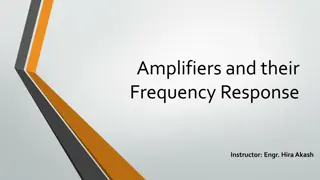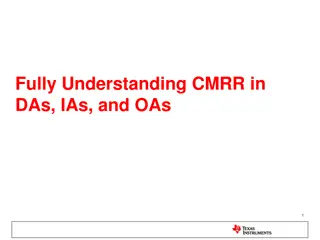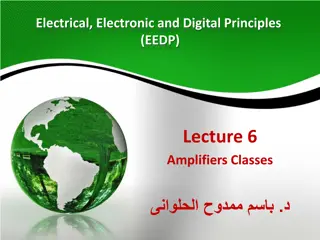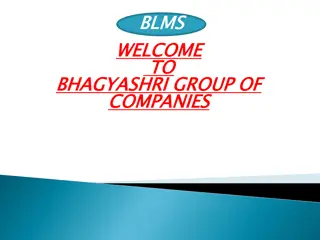Optimizing Gain Tailoring in CO2 Amplifiers for Laser Applications
The research focuses on enhancing gain tailoring in a CO2 amplifier through resonant absorption in hot CO2 cells, crucial for applications such as generating light channels in air, particle acceleration, and laser fusion. The study involves amplification of short pulses, CO2 laser gain spectra analysis, a simulation using the co2amp code, and optimization of key variables like gas mix, temperature, and pressure in the hot cell to improve laser efficiency.
Download Presentation

Please find below an Image/Link to download the presentation.
The content on the website is provided AS IS for your information and personal use only. It may not be sold, licensed, or shared on other websites without obtaining consent from the author.If you encounter any issues during the download, it is possible that the publisher has removed the file from their server.
You are allowed to download the files provided on this website for personal or commercial use, subject to the condition that they are used lawfully. All files are the property of their respective owners.
The content on the website is provided AS IS for your information and personal use only. It may not be sold, licensed, or shared on other websites without obtaining consent from the author.
E N D
Presentation Transcript
Gain Tailoring in a CO2Amplifier by Resonant Absorption in Hot CO2Cell Dana Tovey, Sergei Tochitsky, Eric Welch, Chan Joshi Neptune Lab, Department of Electrical Engineering University of California, Los Angeles
Why is this Important? UCLA Neptune Lab: World s most powerful (15 Terawatt) Carbon Dioxide laser High peak power can only be generated with very short, picosecond (10-12second) pulses When 10 micron laser beam is focused, it produces very strong electrical fields Applications Generation of Light Channels in Air (laser weapon) Particle Acceleration (cancer treatment) Laser Fusion (potential unlimited energy source)
Amplification of Short Pulses Amplified Output Input Time Domain Frequency Domain Time Domain Smooth Gain Spectrum (Ideal) 3 ps Time Frequency Time Modulated Gain Spectrum (Realistic) 3 ps 18 ps Time Frequency Time
CO2 Laser Gain Spectra CO2 Absorption Spectrum at 1 atm Pressure broadening At higher pressure, spectral lines grow wider and overlap, smoothening the spectrum Broader bandwidth means shorter pulses CO2 Absorption Spectrum at 10 atm Possible Solutions Increase pressure (technologically difficult) Use CO2 isotopes to fill gaps in spectra (expensive) ~ 1 THz
My Project CO2 Laser CO2 Hot Cell Eupper Elower gain loss loss gain input gain loss
Numerical Simulations To simulate the effect of a hot cell, I used an open-source code co2amp designed to model amplification of short pulses in active CO2 media [1] Calculates amplitude and phase at each individual frequency Conditions for laser were realistic, given by past experimental results Gain coefficient: 2.2%/cm Pressure: 8 atm (1:1:14 CO2:N2:He mix) Cell Length: 50 cm Simulated amplification of 3 ps pulse from 1 J to 1 mJ Regenerative amplifier: Number of passes varied depending on amount of absorption by hot cell [1] Mikhail N. Polyanskiy, "co2amp: A software program for modeling the dynamics of ultrashort pulses in optical systems with CO2 amplifiers," Appl. Opt. 54, 5136-5142 (2015)
Optimization 3 main variables to optimize for the hot cell Gas Mix (CO2 : N2 : He) Temperature Total Pressure Gas Mix: all results indicate pure CO2 (1:0:0) works best Optimizing Temperature Fixed CO2 Pressure = 2 atm Optimizing Pressure Fixed Temperature = 400 K 0.5 0.5 0.4 0.4 Efficiency Efficiency 0.3 0.3 0.2 0.2 0.1 0.1 0 0 340 390 440 490 0.5 1.5 Pressure [atm] 2.5 3.5 Temperature [Kelvin]
Simulation Results Conditions taken from realistic experimental results Gain coefficient: 2.2%/cm Laser Pressure: 8 atm (1:1:14 CO2:N2:He mix) Cell Length: 50 cm Output without Hot CO2 Cell Output with Hot CO2 Cell
Project Status This academic year I plan to work 8-10 hours/week continuing this project Design for hot cell is complete Currently contacting companies about the building of customized parts Goal: To build the hot cell and test this theory in lab by the conclusion of this academic year Hot CO2 Cell L = 50 cm Brewster s Angle for NaCl = 56























